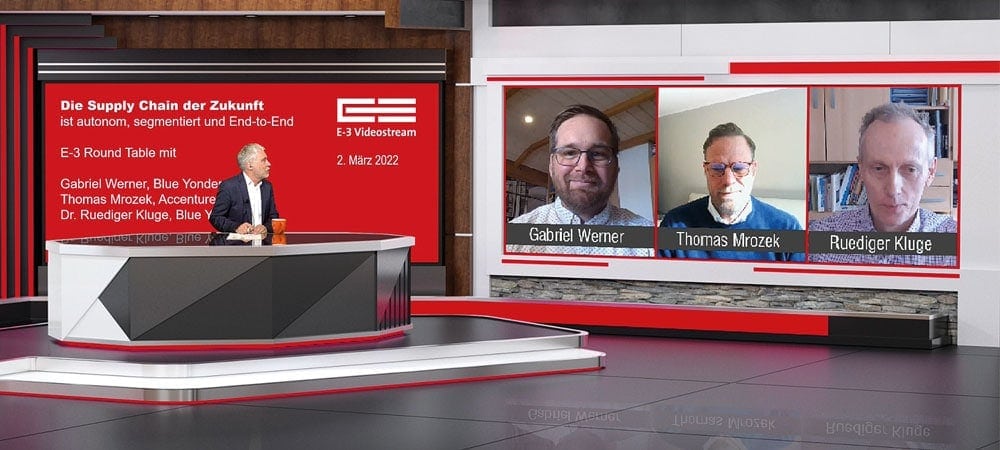Supply chain of the future


Starting from a very homogeneous R/3, individual disciplines have developed at different speeds and in different directions in recent years. Having arrived in the digital transformation, it can be seen that supply chain management has freed itself from the confines of an ERP and become a discipline in its own right - this is a huge challenge for existing SAP customers. Together with Blue Yonder and Accenture, E-3 Magazine has launched a discourse that highlights the autonomy of SCM, but also the interconnectedness with an ERP like SAP Business Suite 7 and S/4 Hana in the back office. We kicked off on March 2 with a live conversation on YouTube. This one-hour discussion is still available for free on the E-3 YouTube channel.
High complexity
"Supply chains and logistics have been around for a long time"Gabriel Werner from Blue Yonder emphasized at the beginning of the discussion and referred to the historical Silk Road between China and Europe. With a big leap, he then came to the present and mentioned areas of expertise from mathematics such as operation research. In his opinion, the challenge was and is the exponentially growing complexity of supply chains. This is where SCM differs from other IT applications such as CRM or HCM. "And of course, this enormous complexity also affects performance", explains BlueYonder manager Werner.
The supply chain still faces huge challenges after more than two years of the pandemic: Chain disruptions, labor shortages, high costs, and unconnected and barely digital systems all affect operations. Speed and scalability are among the two biggest demands that retailers and warehouse operators place on supply chain innovation today.
In the E-3 conversation, Gabriel Werner referred to the importance of new techniques such as AI and machine learning to complement traditional mathematics. A path that seems logical, obvious, but not easy to follow, as SAP also started this attempt with the Leonardo framework. In the meantime, Leonardo has been discontinued again and SAP's existing customers are beginning to look to specialists such as Blue Yonder for guidance: Data Science is now an integral part of strategic supply chain planning. To realistically plan developments, Blue Yonder uses artificial intelligence and machine learning. In logistics, more and more ERP users are relying on AI solutions that enable precise forecasts and optimize supply chains.
However, Werner explains BlueYonder's success not only through the application of AI and ML, but also through its broad availability via cloud computing.
The many possibilities can not only be a blessing, but perhaps also a curse: Can there be the optimal supply chain or is logistics a continuous im-provement? Thomas Mrozek from Accenture makes it clear right at the start that most supply chains are not only global, but also subject to numerous external influences, which makes optimal logistics a dynamic agile goal. "Thus, it is not quite so easy to do it perfectly"is the Accenture manager's first interim summary.
For many years, supply chains - emanating from SAP's APO, Advanced Planner and Optimizer - have been refined and improved piecemeal. For Thomas Mrozek, the new possibilities such as AI, ML, but also cloud computing are also a necessary media break to get an improved supply chain. The more valid data is available, the more reliably the algorithm can make statistically significant predictions. But one thing is certain: as soon as observations (historical data) are used (in a mathematically correct manner), predictions achieve a significantly higher level of accuracy than human assessments - which are often driven by prejudice. However, there will never be 100 percent accurate predictions. This is because people have free will, trends change, billions of environmental influences are difficult to measure and predict, and economic and political factors are subject to continuous change.
So what does a supply chain need to be able to do? By its very nature, the supply chain must be precisely tailored to the needs of the user, says Thomas Mrozek and emphasizes: "In addition, of course, it must be resilient and responsible for employees than enable sustainable and agile working." For the Accenture manager, the three R's - relevant, resilient and responsible - thus lead to a perfect supply chain. Thus, initial supply chain failures such as inaccuracies in procurement processes and determination of inventory levels can be prevented. Further challenges regarding massive disadvantages in sales, logistics processes, environmental aspects and the reputation of a company must also be optimized.
Evolutionary or revolutionary
The numerous challenges on the way to a possibly perfect supply chain also raise the question of whether it can be evolutionary or whether it will be disruptive and revolutionary. In an E-3 conversation, Ruediger Kluge from Blue Yonder distinguishes between the continuous improvement of existing processes, the customer experience, and logistics and the introduction of completely new business processes as part of the digital transformation. "What is needed is a focus on the customer experience"Kluge recommends, and he sees less of an either-or here. Whether it will be an evolution or a revolution depends, according to Blue Wonder manager Kluge, of course on the technology used - AI and ML certainly offer completely new dimensions for the customer experience.
In the classic supply chain, individual predictability is limited; the optimal forecast is a probability for every possible future that is as individualized and as sharp as possible. Natural scientists and statisticians know the limits of predictability. There is a difference between deterministic and probabilistic science. In the former, a definitive answer is always sought - rules that verify an observation 100 percent. However, the vast majority of logistics chains are not deterministic, but probabilistic. Here, Blue Yonder tries to use as many observations as possible to expand knowledge about trends, patterns, environmental influences and regularities and predict them in the form of probability distributions. Accordingly, AI will play a supporting role in supply chains.
Blue Yonder is a platform provider for digital end-to-end supply chains (E2E) and omni-channel commerce fulfillment. Accurate demand forecasting enables companies to better serve demand and optimize the customer experience. They can also dynamically improve the planning and execution of business strategies to achieve more profitable results.
Autonomous and E2E
The supply chain of the future is therefore autonomous, segmented and end-to-end. An important finding from the E-3 discussion with Gabriel Werner and Ruediger Kluge from Blue Yonder and Thomas Mrozek from Accenture is that heterogeneous system landscapes still exist at many existing SAP customers. This often leads to silo architectures and consequently to fragmented supply chains. In addition, the lifecycle of common SAP tools in supply chain management is expected to end in 2027. Doubts about the availability of some S/4 products seem to be justified; at any rate, the initial reactions of existing SAP customers based on numerous conversations with the E-3 editorial team are restrained. In order not to lose the connection here, companies must react now and reorient themselves.
Blue Yonder offers AI algorithms that can be used to reorganize supply chain processes: For example, flows of goods can be automatically rerouted within minutes so that recipients are reliably supplied from other sources. Delayed deliveries can also be forecast very promptly so that recipients can react quickly. In order to design these processes consistently, not only a good SAP ERP system is required in the back office. The relevant data should be consolidated on a central supply chain platform so that a wide variety of applications can use it. AI solutions help here and close gaps left by other supply chain solutions and products.
Finally, Gabriel Werner emphasizes the aspect of value creation: "Here, of course, the big picture of an SCM project that spans several years counts, but so does the logical segmentation of the path so as not to lose sight of the big picture and also to use the optimal technology at each step." Thomas Mrozek also calls for a holistic vision at the beginning, including the definition and review of milestones. "What is important, however, is the customer focus in supply chain automation, which should be designed to be data-driven"emphasizes Accenture manager Mrozeck at the end of the conversation. "Every existing SAP customer should seize the opportunity to enrich their solution portfolio with additional providers", Ruediger Kluge concludes by motivating the SAP community to evaluate a best-of-breed approach to supply chains.
SCM Round Table
The current To the YouTube video stream (German audio w/ automatically generated English subtitles available) of the one-hour E-3 discussion with Gabriel Werner and Dr. Ruediger Kluge from Blue Yonder and Thomas Mrozek from Accenture is available free of charge at any time via the E-3 YouTube channel retrievable.





